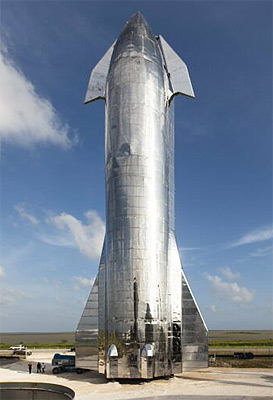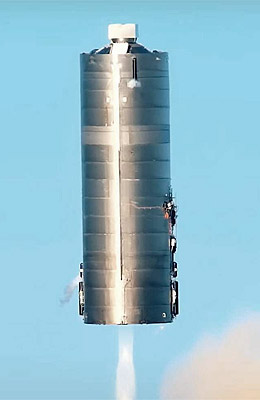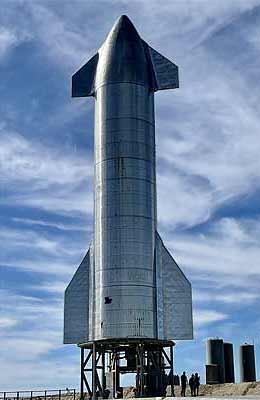Thank you very much for visiting Gunter's Space Page. I hope that this site is useful and informative for you.
If you appreciate the information provided on this site, please consider supporting my work by making a simple and secure donation via PayPal. Please help to run the website and keep everything free of charge. Thank you very much.
Starship (BFS, Big Falcon Spaceship)
 Starship Mk.1 [SpaceX] |
 Starship SN5 (F1) [SpaceX] |
 Starship SN8 [SpaceX] |
Starship (formerly known as BFR (Big Falcon Rocket and BFS (Big Falcon Spaceship) is a planned very large completely reusable crewed launch system by SpaceX that is intended by the company to replace all SpaceX's existing launch vehicles and spacecraft by the mid 2020s.
The rockets are completely reusable on both stages. The expected landing reliability is to be on a par with major airliners. The vehicle has a principal diameter of 9 meters and is built from stainless steel. It is powered by SpaceX own Raptor engines running on liquid methane and oxygen. The Super Heavy Starship will be 118 m high and will weigh 4400 t at launch.
The system consists of two parts:
- The 68 m long booster stage, called Super Heavy, which is powered by 37 Raptor engines. This stage will either return to the launch site or land off-shore on a floating platform by powered reentry and landing. On reentry, the stage is steered by four large actuated grid fins and lands on six landing legs shaped as fins. The stage has a propellant capacity of 3300 tons.
- The 50 m Starship upper stage is also built from stainless steel with a principal diameter of 9 m. This stage is powered by 3 standard Raptor engines and 3 fixed vaccum-optimzed raptor engines. The Super Heavy Starship has a dry mass of 85 tons and has a propellant capacity of 1200 tons. The ascent payload capacity is 150 t to low earth orbit and it has a return capacity of 50 t. The Starship is to reenter belly-first with two aft fins and two canards provide skydiver-like steering. The maximum heating areas are covered by rugged ceramic-tiles. The Starship comes in different versions as crewed ships, cargo ships or tankers for in-orbit refueling of other Starships. The front part houses either the crew compartments, cargo compartments or tanks. Starships are are capable of automated rendezvous and docking. It is also designed to be able to land both on moon and Mars. The Spaceship contains 1000-1100 m3 of pressurized volume; could be configured with 40 cabins, large common areas, central storage, galley, and a solar storm shelter in Mars transit configuration.
Launch sites are at Boca Chica, Texas, and at Cape Canaveral, Florida.
The first test version with only three engines, Starship Mk.1 was built in Boca Chica and was to conduct an atmospheric flight to 20 km altitude in late 2019. On 20 November 2019, the vehicles tank bukheads failed during a tanking and pressurization test. Before the incident, it was announced, that Starship Mk.1 would not be used for flight. A similar Starship Mk.2 was under construction in Cocoa Beach, Florida, for suborbital testflights from Cape Canaveral, featuring single weld rings for the structure. This version has also been cancelled with parts already built being scrapped. An improved version with six engines, Starship Mk.3, was to be built at Boca Chica. It will be used for suborbital flight tests, but will be able to reach orbit. A similar version, Starship Mk.4 was to be used for test flights from Cape Canaveral.
A number of prototypes were built and pressure tested, leading to several failures. Eventually Starship SN5 was the first to be flight tested with only one engin and without nosecone or fins on an 150 m hop on 5 August 2020. The mostly identical Starship SN6 repeated this in September 2020. In November, Starship SN8 featuring 3 engines, nosecone and flaps is planned to conduct a flight to 15 km altitude.
| Version | Stage 1 |
|---|---|
| Starship Mk.1 | Starship Mk.1 / 3 × Raptor |
| Starship Mk.2 | Starship Mk.2 / 3 × Raptor |
| Starship Mk.3 | Starship Mk.3 / 3 × Raptor, 3 × Raptor-Vac |
| Starship Mk.4 | Starship Mk.4 / 3 × Raptor, 3 × Raptor-Vac |
| Starship SN5/SN6 | Starship SN5/SN6 / 1 × Raptor |
| Starship SN8-SN11 | Starship SN8-SN11 / 3 × Raptor |
| Starship SN15-SN19 | Starship SN15-SN19 / 3 × Raptor |
| Starship SN21-SNx | Starship SN21-SNx / x × Raptor |
| Starship | Starship / 3 × Raptor-2, 3 × Raptor-2Vac |
| Performance (kg) | LEO | LPEO | SSO | GTO | GEO | MolO | IP |
|---|---|---|---|---|---|---|---|
| Starship Mk.3 | |||||||
| Starship Mk.4 |
No.TypNo Type Date LS Payload
3 1 Starship SN5/6 05.08.2020 * BC LP-A Starship SN5 F1 R&D (150 m) 4 2 Starship SN5/6 03.09.2020 * BC LP-A Starship SN6 F1 R&D (150 m) 5 1 Starship SN8-11 09.12.2020 * r BC LP-A Starship SN8 F1 R&D (12 km) 6 2 Starship SN8-11 02.02.2021 * r BC LP-A Starship SN9 F1 R&D (10 km) 7 3 Starship SN8-11 03.03.2021 * r BC LP-A Starship SN10 F1 R&D (10 km) 8 4 Starship SN8-11 30.03.2021 * F BC LP-A Starship SN11 F1 R&D (10 km) 9 1 Starship SN15-19 05.05.2021 * BC LP-A Starship SN15 F1 R&D (10 km) planned launches Launch sites: BC = Starbase (SpaceX South Texas Launch Site) , Boca Chica, Texas, USACCK = NASA John F. Kennedy Space Center, Cape Canaveral, Florida, USA

Source: SpaceX Website
